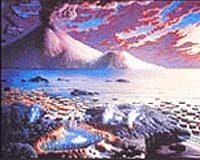| . |  |
. |
Uppsala, Sweden (SPX) Jan 11, 2010 The discovery of fossil footprints from early backboned land animals in Poland leads to the sensational conclusion that our ancestors left the water at least 18 million years earlier than previously thought. The results of the Polish-Swedish collaboration are published online this week in Nature. These results force us to reconsider our whole picture of the transition from fish to land animals, says Per Ahlberg of Uppsala University, one of the two leaders of the study. For nearly eighty years, palaeontologists have been scouring the planet for fossil bones and skeletons of the earliest land vertebrates or "tetrapods" - the ultimate progenitors of all later amphibians, reptiles, birds and mammals including ourselves. Their discoveries have suggested that the first tetrapods evolved relatively rapidly from lobe-finned fishes, through a short-lived intermediate stage represented by "elpistostegids" such as Tiktaalik, about 380 million years ago. But there is another potential source of information about the earliest tetrapods: the fossilized footprints they left behind. In the new study a Polish-Swedish team describe a rich and securely dated footprint locality from Zachelmie Quarry in Poland that pushes back the origin of tetrapods a full 18 million years beyond the earliest skeletal evidence and forces a dramatic reassessment of the transition from water to land. The trackways show that large tetrapods, up to three metres in length, inhabited the marine intertidal zone during the early Middle Devonian some 395 million years ago. This means not that not only tetrapods but also elpistostegids originated much earlier than we thought, because the position of elpistostegids as evolutionary precursors of tetrapods is not in doubt, and so they must have existed at least as long, says Per Ahlberg. The elpistostegids, it seems, were not at all a short-lived transitional stage but must have existed alongside their descendants the tetrapods for at least 10 million years. The environment is also a major surprise: almost all previous scenarios for the origin of tetrapods have placed this event in a freshwater setting and have associated it with the development of land vegetation and a terrestrial ecosystem. Instead, our distant ancestors may first have left the water in order to feed on stranded marine life left behind by the receding tide, says Per Ahlberg.
Share This Article With Planet Earth
Related Links Uppsala University Explore The Early Earth at TerraDaily.com
 How The Earth Survived Birth
How The Earth Survived BirthWashington DC (SPX) Jan 08, 2010 For the last 20 years, the best models of planet formation-or how planets grow from dust in a gas disk-have contradicted the very existence of Earth. These models assumed locally constant temperatures within a disk, and the planets plunge into the Sun. Now, new simulations from researchers at the American Museum of Natural History and the University of Cambridge show that variations in tem ... read more |
|
| The content herein, unless otherwise known to be public domain, are Copyright 1995-2009 - SpaceDaily. AFP and UPI Wire Stories are copyright Agence France-Presse and United Press International. ESA Portal Reports are copyright European Space Agency. All NASA sourced material is public domain. Additional copyrights may apply in whole or part to other bona fide parties. Advertising does not imply endorsement,agreement or approval of any opinions, statements or information provided by SpaceDaily on any Web page published or hosted by SpaceDaily. Privacy Statement |